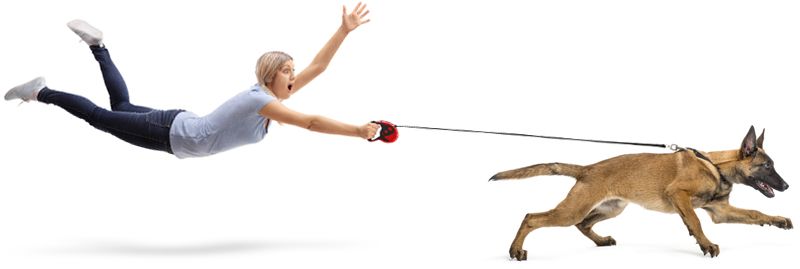
Is your dog barking, lunging, growling on the leash?
What’s really going on?
An unleashed dog is free to react to on-comers in their normal fashion. But a dog on a leash is restricted; it can only cope by using the resources at paw (so to speak): its eyes, its bark and its teeth. Encounters that don’t go well create fear and tension in owners, which in turn reinforces the dog’s initial sense of fear and/or tension. At All About My Dog, we believe the key to non-reactive leash walking is to reduce or eliminate your dog’s need to react, i.e. help your dog stay calm.
Exercise your dog.
A well-exercised dog is less likely to meet other dogs/humans in an excited or anxious state of mind. This is common sense.
But, [you say] I need to walk my dog on a leash in order to exercise him.
Read on! [we say]
Lead your dog down the street.
The dog that meets other dogs from a position “in front” of their owner is likely to feel in charge, and possibly vulnerable. A vulnerable dog is an anxious dog. The dog lover who takes a back-leash position is saying to his pup — Dude, take care of the situation for me, will ya?
Position your dog on the far side of danger.
A dog owner who remembers to position her dog on her far side, the side away from oncoming traffic, barking dogs, and sputtering garbage trucks says to the dog — Don’t worry.
Seriously? [you say] I’m supposed to stand between my dog and what they’re reacting to?
Yes! [we say] Create a barrier. At All About My Dog, we call it making a den.
Keep your dog with you.
No visiting until you have vetted the object of your dog’s attention.
But, [you say] what if the other dog charges across the street, pulling its owner while the helpless human shouts, “My dog’s friendly. Is yours?”
[We say]
- step in front of your dog,
- shorten/not tighten the leash so your dog stays with you,
- and say to the oncoming owner: “No thank you,” or “We’re in training.”
Keep your dog with you.
This one is so important we decided to say it twice. Once you’ve positioned your dog on the side farthest away from danger, position yourself at your dog’s front end. Not its back. Not six feet away. Hold your dog’s hand – so to speak. Be there when your pup needs you.
Walk On.
You DO NOT have to meet every dog/owner on the planet. If you decide to walk on, do not turn your back (or your dog’s backside) to the other dog/owner pair. Walk forward with your dog on your far side.
Step on the leash.
If you decide to visit, keep your dog with you until you decide it is appropriate for the dogs themselves to meet. (We’ll address proper meets and greets in another post.)
Stepping on the leash in addition to holding the handle will ensure that your dog stays with you. Again, a dog that’s with its owner is safe. A dog that visits on its own is likely to become excited and anxious.
Honor your dog.
Proper dog to dog meetings are quiet and respectful. Avoid over-stimulating your dog with treats or loud, excited gestures and voices. The way you interact with your dog signals how you expect your dog to interact with others. If you saw a barking, jumping dog, would you want to say hello? Guess what? Your pup feels the same way.
Take the pressure off your dog.
When your dog is close to you, it feels safe. If your dog reacts, place your dog behind you. Keep your dog there until the danger passes or he becomes calm.
Be calm.
Use a calm, normal voice when you talk to your dog and when you talk to neighbors, other dogs, other owners and passersby. A calm owner makes for a calm dog.
[We say] Sound familiar?
Thank you for these tips. My dog, Finnegan, and I took a couple classes with you where we practiced these techniques and it made a world of difference. He used to pull on the leash, lunge at joggers, bark at skateboarders wildly, etc. It was stressful for him and for me. Now he walks on a loose leash and it is so much more enjoyable for the both of us. Neighbors, friends and family members have noticed the difference. He is a new dog. Thank you for your help. You have excellent tips.
Thank you for letting us know! We’re delighted Finnegan is doing so well. For more of those excellent tips, check out our training videos. We look forward to seeing you back at AAMD when we reopen.
We just adopted a 10 month old anxious Samoyed. After one class he is a new dog and much more relaxed. We look forward to additional advice! Your techniques are spot on!
Thanks Eileen – keeping your dog calm is all about being calm yourself and communicating. You guys are doing a great job!